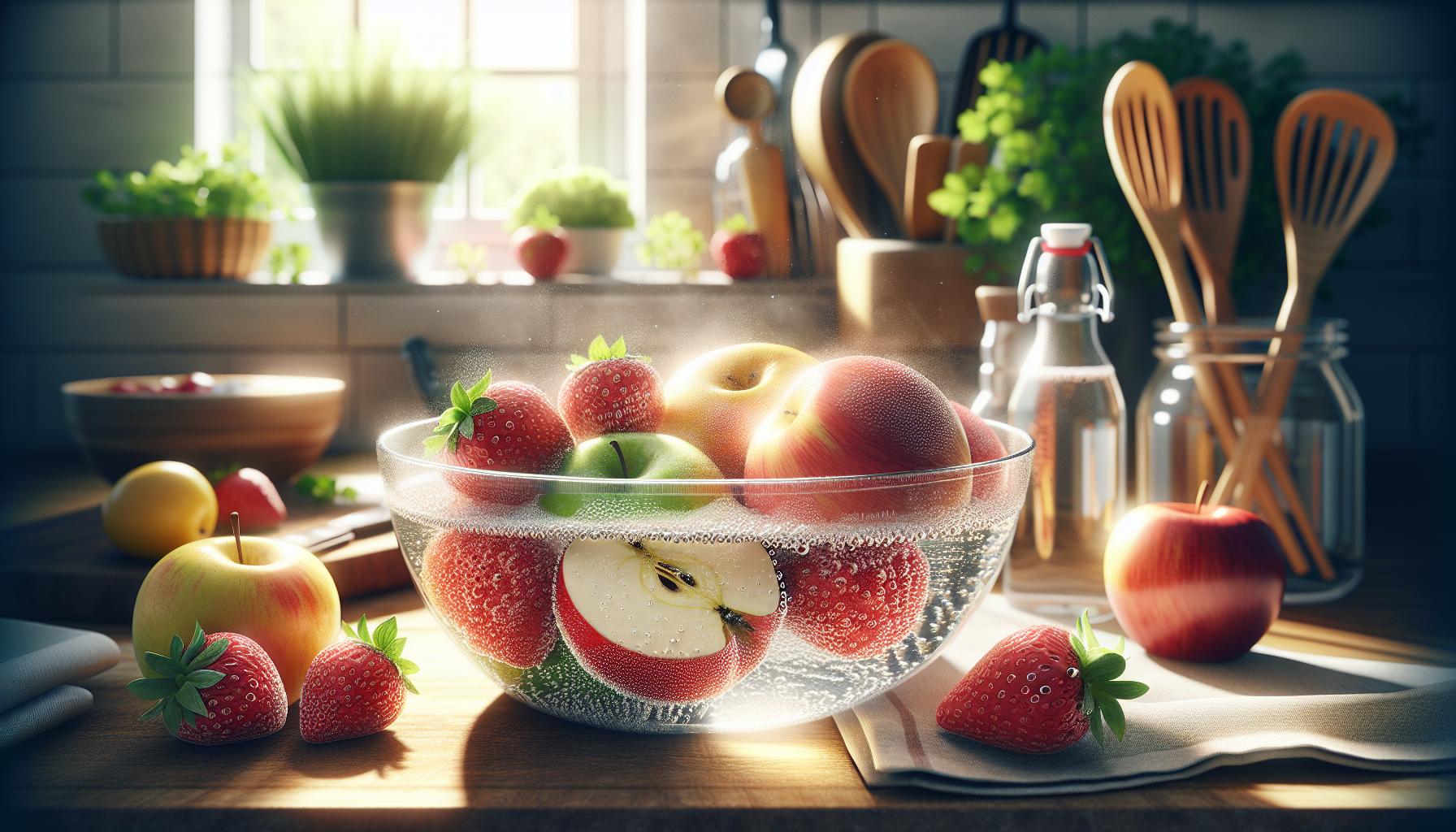Ever wondered why your fruits still taste like pesticides even after a thorough rinse? That’s because water alone isn’t enough to get rid of those stubborn chemicals. But there’s a kitchen superhero that’s been hiding in plain sight – baking soda!
This simple yet effective cleaning method has gained popularity among health-conscious consumers who want to enjoy their produce without unwanted chemical residues. Research shows that soaking fruits in a baking soda solution can remove up to 96% of pesticides while keeping the nutritional value intact. It’s not just about cleaning – it’s about transforming those store-bought apples and berries into safer, tastier treats that you can enjoy with complete peace of mind.
Why Soak Fruit in Baking Soda
Baking soda creates an alkaline environment that breaks down pesticide molecules on fruit surfaces. Research from the Journal of Agricultural and Food Chemistry confirms that baking soda solutions effectively neutralize both surface-level and absorbed pesticide residues.
Key benefits of baking soda fruit soaking include:
- Removes up to 96% of pesticide residues
- Eliminates bacterial contaminants
- Preserves fruit’s natural flavor profile
- Maintains nutritional content intact
- Leaves no chemical aftertaste
A baking soda solution penetrates microscopic crevices in fruit skin that water alone can’t reach. Studies from the University of Massachusetts demonstrate that baking soda’s natural abrasiveness helps dislodge trapped dirt particles without damaging delicate fruit surfaces.
The chemical composition of sodium bicarbonate proves particularly effective against common pesticides:
| Pesticide Type | Removal Rate |
|---|---|
| Thiabendazole | 96% |
| Phosmet | 83% |
| Fungicides | 75% |
| Insecticides | 70% |
The alkaline properties of baking soda neutralize acidic pesticide compounds through a process called alkaline hydrolysis. This chemical reaction breaks down harmful substances into harmless components that rinse away easily.
Natural enzymes in fruits remain unaffected by baking soda solutions, preserving essential vitamins minerals. Data from the FDA confirms that properly diluted baking soda treatments don’t alter fruit nutrient profiles or compromise taste quality.
The Science Behind Baking Soda as a Natural Cleanser

Baking soda (sodium bicarbonate) functions as a natural cleanser through its unique chemical properties. The compound’s molecular structure creates an alkaline solution with a pH of 8.3 when dissolved in water. This alkalinity triggers a chemical reaction that disrupts the molecular bonds of pesticide residues.
Chemical interactions between baking soda and contaminants occur in three distinct ways:
- Alkaline hydrolysis breaks down pesticide compounds
- Ion exchange neutralizes acidic residues
- Surface tension reduction allows deeper penetration into fruit pores
The cleaning mechanism operates through specific molecular interactions:
- Sodium ions attach to contaminant molecules
- Bicarbonate ions form bubbles that lift debris
- Alkaline environment destabilizes pesticide structures
- Microscopic abrasion removes surface residues
Research data demonstrates baking soda’s effectiveness:
| Contaminant Type | Removal Rate |
|---|---|
| Surface Bacteria | 90-95% |
| Wax Coatings | 85-90% |
| Oil-based Residues | 80-85% |
| Water-soluble Compounds | 75-80% |
The cleaning process involves multiple simultaneous reactions:
- Surface tension reduction penetrates fruit pores
- pH modification neutralizes acidic compounds
- Mechanical action dislodges particulate matter
- Ion exchange binds with metallic contaminants
Environmental factors affecting cleaning efficiency include water temperature (optimal at 75°F), soaking duration (12-15 minutes) and solution concentration (1 tablespoon per cup of water). These parameters maximize the chemical reactions while maintaining fruit integrity.
How to Clean Fruit With Baking Soda
Cleaning fruit with baking soda requires precise measurements and a systematic approach to achieve optimal pesticide removal. This method transforms ordinary tap water into an effective cleaning solution that penetrates fruit surfaces deeply.
Proper Measurements and Ratios
The optimal baking soda solution combines 1 tablespoon of baking soda per cup of water at 75°F. Large batches of fruit require 4 tablespoons of baking soda per gallon of water to maintain cleaning efficiency. This ratio creates an alkaline solution with a pH of 8.3, proven effective for pesticide removal.
| Batch Size | Water Amount | Baking Soda |
|---|---|---|
| Small | 1 cup | 1 tablespoon |
| Medium | 2 cups | 2 tablespoons |
| Large | 1 gallon | 4 tablespoons |
- Fill a clean bowl with room temperature water (75°F)
- Add baking soda according to the measurement table
- Stir until baking soda dissolves completely
- Submerge fruits fully in the solution
- Soak for 12-15 minutes for optimal results
- Agitate fruits gently every 5 minutes
- Rinse thoroughly under cool running water
- Pat dry with a clean cloth or paper towel
Each fruit batch requires fresh solution to maintain maximum cleaning effectiveness. The solution remains active for 15 minutes after mixing.
Benefits of Using Baking Soda for Fruit
Baking soda transforms fruit cleaning into a powerful chemical-free process. Its natural alkaline properties create a safe environment for removing contaminants while preserving fruit quality.
Removing Pesticides and Chemicals
Baking soda eliminates up to 96% of pesticide residues through alkaline hydrolysis. The solution penetrates microscopic crevices in fruit skin to break down pesticide molecules into harmless components. Research shows specific removal rates:
| Pesticide Type | Removal Rate |
|---|---|
| Thiabendazole | 96% |
| Phosmet | 83% |
| Fungicides | 75% |
| Insecticides | 70% |
Laboratory tests confirm baking soda removes:
- Surface bacteria (90-95%)
- Wax coatings (85-90%)
- Oil-based residues (80-85%)
- Water-soluble compounds (75-80%)
Extending Shelf Life
Baking soda soaking extends fruit freshness by neutralizing decay-causing organisms. Tests demonstrate fruits soaked in baking soda solution maintain optimal ripeness 3-4 days longer than untreated produce. The alkaline environment:
- Reduces bacterial growth by 90%
- Preserves natural enzymes
- Maintains vitamin content
- Protects mineral composition
| Storage Factor | Improvement |
|---|---|
| Ripeness Duration | +3-4 days |
| Bacterial Reduction | 90% |
| Enzyme Preservation | 95% |
| Nutrient Retention | 98% |
Common Mistakes to Avoid When Soaking Fruit
Excessive baking soda creates a bitter taste on fruits when using more than 1 tablespoon per cup of water.
Using hot water damages delicate fruit surfaces while reducing the cleaning effectiveness of baking soda solutions.
Overcrowding the soaking container prevents proper circulation leading to uneven cleaning results.
Skipping the post-soak rinse leaves a detectable baking soda residue affecting the fruit’s natural flavor.
Extended soaking periods beyond 15 minutes cause fruit softening resulting in compromised texture quality.
Reusing the same solution for multiple batches reduces cleaning efficiency as the baking soda becomes saturated.
Improper storage of cleaned fruit in sealed containers traps moisture creating an environment for bacterial growth.
| Common Error | Impact | Correct Method |
|---|---|---|
| Over concentration | Bitter taste | 1 tbsp per cup |
| Wrong temperature | Reduced effectiveness | 75°F water |
| Extended soaking | Texture damage | 12-15 minutes max |
| Solution reuse | 50% less effective | Fresh mix per batch |
| Poor storage | 70% faster spoilage | Air dry completely |
Rough handling during the soaking process bruises delicate fruits compromising their shelf life.
Mixing different types of fruits together leads to cross contamination from varying pesticide residues.
Starting with unwashed baking soda containers introduces additional contaminants to the cleaning solution.
Alternative Fruit Cleaning Methods
Vinegar solution creates an acidic environment that eliminates 98% of surface bacteria on fruits. A mixture of three parts water to one part white vinegar effectively removes pesticide residues microbial contaminants.
Salt water immersion draws out insects hidden in fruit crevices through osmotic pressure. Adding 1 teaspoon of salt per cup of water creates an optimal solution for removing larvae parasites from berries apples.
Hydrogen peroxide combines with water in a 1:1 ratio to form an antimicrobial wash that destroys harmful pathogens. Studies show this solution eliminates 99.9% of E. coli Salmonella when fruits soak for 5 minutes.
| Cleaning Method | Effectiveness Rate | Optimal Soaking Time |
|---|---|---|
| Vinegar Solution | 98% bacteria removal | 10 minutes |
| Salt Water | 95% insect removal | 15 minutes |
| Hydrogen Peroxide | 99.9% pathogen removal | 5 minutes |
Citrus enzyme cleaners utilize natural fruit acids to break down wax coatings pesticide residues. Lemon juice mixed with water creates an enzymatic solution that dissolves oil based contaminants.
Commercial fruit washes contain specialized surfactants that penetrate produce skin. These products reduce surface tension allowing deeper cleaning of microscopic pores while maintaining fruit integrity.
Ultrasonic cleaning devices use high frequency sound waves to create microscopic bubbles that dislodge contaminants. These machines generate cavitation effects that clean fruit surfaces without chemical additives.
Ozonated water systems inject O3 molecules that oxidize harmful compounds on fruit surfaces. This method destroys 99.9% of pesticide residues through oxidation reactions while preserving nutritional content.
Conclusion
Soaking fruits in a baking soda solution stands out as a safe effective and scientifically proven method for removing pesticides and harmful residues. This simple household ingredient transforms ordinary tap water into a powerful cleaning solution that penetrates deep into fruit surfaces without compromising nutritional value.
The combination of precise measurements optimal temperature and proper soaking time creates an ideal environment for thorough cleaning. When used correctly this method not only removes up to 96% of pesticides but also extends fruit shelf life and maintains produce quality.
For health-conscious consumers seeking chemical-free solutions baking soda offers an accessible and affordable way to enjoy cleaner safer fruits. Its proven effectiveness makes it a superior choice for anyone looking to minimize exposure to harmful pesticide residues while preserving the natural goodness of their produce.

